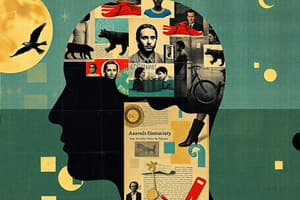Podcast
Questions and Answers
Which lobe of the cerebral cortex is responsible for processing visual information?
Which lobe of the cerebral cortex is responsible for processing visual information?
- Occipital Lobe (correct)
- Parietal Lobe
- Frontal Lobe
- Temporal Lobe
What is the primary function of the motor cortex?
What is the primary function of the motor cortex?
- Processing auditory information
- Controlling voluntary movements (correct)
- Regulating emotions
- Interpreting sensory information
Which area of the cerebral cortex processes body touch and movement sensations?
Which area of the cerebral cortex processes body touch and movement sensations?
- Visual Cortex
- Somatosensory Cortex (correct)
- Motor Cortex
- Auditory Cortex
What is the corpus callosum?
What is the corpus callosum?
What term describes the brain's ability to form new neurons?
What term describes the brain's ability to form new neurons?
What is the main function of dendrites?
What is the main function of dendrites?
Which part of the neuron contains the nucleus?
Which part of the neuron contains the nucleus?
What is the role of glial cells in the nervous system?
What is the role of glial cells in the nervous system?
What is the tiny gap between neurons called?
What is the tiny gap between neurons called?
What does the 'all-or-none law' refer to?
What does the 'all-or-none law' refer to?
Which system is the body's 'slow' chemical communication system?
Which system is the body's 'slow' chemical communication system?
What is the brain's ability to change by reorganizing after damage?
What is the brain's ability to change by reorganizing after damage?
Which lobe of the cerebral cortex is associated with touch and body position?
Which lobe of the cerebral cortex is associated with touch and body position?
Flashcards
Plasticity
Plasticity
The brain’s ability to change by reorganizing after damage or based on experience.
Neuron
Neuron
A nerve cell; the basic building block of the nervous system.
Dendrites
Dendrites
Extensions of a neuron that receive and integrate messages towards the cell body.
Axon
Axon
Signup and view all the flashcards
Neurotransmitter
Neurotransmitter
Signup and view all the flashcards
All-or-None Law
All-or-None Law
Signup and view all the flashcards
Refractory Period
Refractory Period
Signup and view all the flashcards
Endocrine System
Endocrine System
Signup and view all the flashcards
Occipital Lobes
Occipital Lobes
Signup and view all the flashcards
Motor Cortex
Motor Cortex
Signup and view all the flashcards
Association Areas
Association Areas
Signup and view all the flashcards
Corpus Callosum
Corpus Callosum
Signup and view all the flashcards
Neurogenesis
Neurogenesis
Signup and view all the flashcards
Study Notes
Brain Plasticity and Function
- Brain plasticity is the brain's ability to change, particularly during childhood, by reorganizing after injury or forming new pathways based on experiences.
Nervous System Components
- Neuron: The basic unit of the nervous system, a nerve cell.
- Cell Body: The neuron's life-support center, containing the nucleus.
- Dendrites: Neuron extensions that receive and transmit messages toward the cell body.
- Axon: The neuron extension that sends messages to other neurons, muscles, or glands.
- Action Potentials: Brief electrical impulses that travel down the axon.
- Glial Cells: Support, nourish, and protect neurons; play a role in learning, memory, and thinking.
- Synapses: Junctions between neurons where messages pass.
- Synaptic Gap/Cleft: The tiny space between neurons at a synapse.
- Neurotransmitters: Chemicals released by neurons to transmit messages across synapses.
- All-or-None Law: Neurons fire completely or not at all.
- Threshold: The stimulation level required to trigger a neural impulse.
- Refractory Period: Brief pause after a neuron fires, preventing immediate subsequent firing.
Nervous System Structures and Functions
- Nervous System: The body's electrochemical communication network.
- Peripheral Nervous System: Sensory and motor neurons connecting the central nervous system to the rest of the body.
- Central Nervous System: The brain and spinal cord.
- Endocrine System: The body's "slow" chemical communication system, using hormones.
- Hormones: Chemical messengers that travel through the bloodstream, affecting tissues.
- Limbic System: Neural system associated with emotions and drives (amygdala, hypothalamus, and hippocampus).
- Frontal Lobes: Involved in speaking, muscle movements, planning, and judgments.
- Parietal Lobes: Receive sensory input for touch and body position.
- Occipital Lobes: Receive information from visual fields.
- Temporal Lobes: Receive information from the ears.
- Motor Cortex: Controls voluntary movements.
- Somatosensory Cortex: Registers and processes sensations like touch and body movement.
- Association Areas: Involved in higher mental functions like learning, remembering, thinking, and speaking.
- Corpus Callosum: Connects the two brain hemispheres, allowing communication between them.
- Neurogenesis: Formation of new neurons.
States of Awareness
- Consciousness: Subjective awareness of oneself and the environment.
- Selective Attention: Focusing awareness on a specific stimulus.
- Inattentional and Change Blindness: Failing to notice changes in the environment, a form of inattentional blindness.
Studying That Suits You
Use AI to generate personalized quizzes and flashcards to suit your learning preferences.
Description
This section discusses brain plasticity, which is the brain's ability to change, especially in childhood. It also introduces fundamental components of the nervous system such as neurons, cell bodies, dendrites, axons, glial cells, synapses, and neurotransmitters.




